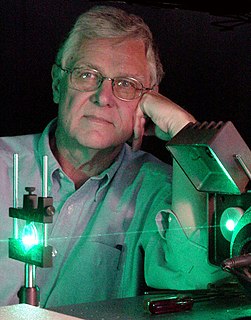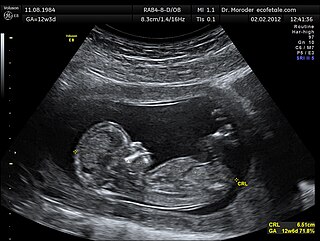
A transmission medium is something that can mediate the propagation of signals for the purposes of telecommunication.

The photophone is a telecommunications device that allows transmission of speech on a beam of light. It was invented jointly by Alexander Graham Bell and his assistant Charles Sumner Tainter on February 19, 1880, at Bell's laboratory at 1325 L Street in Washington, D.C. Both were later to become full associates in the Volta Laboratory Association, created and financed by Bell.

In electronics and telecommunications a transmitter or radio transmitter is an electronic device which produces radio waves with an antenna. The transmitter itself generates a radio frequency alternating current, which is applied to the antenna. When excited by this alternating current, the antenna radiates radio waves.

In telecommunications, frequency-division multiplexing (FDM) is a technique by which the total bandwidth available in a communication medium is divided into a series of non-overlapping frequency bands, each of which is used to carry a separate signal. This allows a single transmission medium such as a cable or optical fiber to be shared by multiple independent signals. Another use is to carry separate serial bits or segments of a higher rate signal in parallel.

Radio waves are a type of electromagnetic radiation with wavelengths in the electromagnetic spectrum longer than infrared light. Radio waves have frequencies as high as 300 gigahertz (GHz) to as low as 30 hertz (Hz). At 300 GHz, the corresponding wavelength is 1 mm, and at 30 Hz is 10,000 km. Like all other electromagnetic waves, radio waves travel at the speed of light in vacuum. They are generated by electric charges undergoing acceleration, such as time varying electric currents. Naturally occurring radio waves are emitted by lightning and astronomical objects.

In electronics, a remote control or clicker is an electronic device used to operate another device from a distance, usually wirelessly. For example, in consumer electronics, a remote control can be used to operate devices such as a television set, DVD player or other home appliance, from a short distance. A remote control is primarily a convenience feature for the user, and can allow operation of devices that are out of convenient reach for direct operation of controls. In some cases, remote controls allow a person to operate a device that they otherwise would not be able to reach, as when a garage door opener is triggered from outside or when a Digital Light Processing projector that is mounted on a high ceiling is controlled by a person from the floor level.

In telecommunications, a carrier wave, carrier signal, or just carrier, is a waveform that is modulated (modified) with an input signal for the purpose of conveying information. This carrier wave usually has a much higher frequency than the input signal does. The purpose of the carrier is usually either to transmit the information through space as an electromagnetic wave, or to allow several carriers at different frequencies to share a common physical transmission medium by frequency division multiplexing. The term originated in radio communication, where the carrier wave is the radio wave which carries the information (modulation) through the air from the transmitter to the receiver. The term is also used for an unmodulated emission in the absence of any modulating signal.

In electronics, ring modulation is a signal-processing function, an implementation of frequency mixing, performed by multiplying two signals, where one is typically a sine wave or another simple waveform and the other is the signal to be modulated. A ring modulator is an electronic device for ring modulation. A ring modulator may be used in music synthesizers and as an effects unit.
A continuous wave or continuous waveform (CW) is an electromagnetic wave of constant amplitude and frequency, typically a sine wave, that for mathematical analysis is considered to be of infinite duration. Continuous wave is also the name given to an early method of radio transmission, in which a sinusoidal carrier wave is switched on and off. Information is carried in the varying duration of the on and off periods of the signal, for example by Morse code in early radio. In early wireless telegraphy radio transmission, CW waves were also known as "undamped waves", to distinguish this method from damped wave signals produced by earlier spark gap type transmitters.

The Pockels effect, or Pockels electro-optic effect, changes or produces birefringence in an optical medium induced by an electric field. In the Pockels effect, also known as the linear electro-optic effect, the birefringence is proportional to the electric field. In the Kerr effect, the refractive index change (birefringence) is proportional to the square of the field. The Pockels effect occurs only in crystals that lack inversion symmetry, such as lithium niobate, and in other noncentrosymmetric media such as electric-field poled polymers or glasses.
The Kerr effect, also called the quadratic electro-optic (QEO) effect, is a change in the refractive index of a material in response to an applied electric field. The Kerr effect is distinct from the Pockels effect in that the induced index change is directly proportional to the square of the electric field instead of varying linearly with it. All materials show a Kerr effect, but certain liquids display it more strongly than others. The Kerr effect was discovered in 1875 by John Kerr, a Scottish physicist.
A television transmitter is a transmitter that is used for terrestrial (over-the-air) television broadcasting. It is an electronic device that radiates radio waves that carry a video signal representing moving images, along with a synchronized audio channel, which is received by television receivers belonging to a public audience, which display the image on a screen. A television transmitter, together with the broadcast studio which originates the content, is called a television station. Television transmitters must be licensed by governments, and are restricted to a certain frequency channel and power level. They transmit on frequency channels in the VHF and UHF bands. Since radio waves of these frequencies travel by line of sight, they are limited by the horizon to reception distances of 40-60 miles depending on the height of transmitter station.
An acousto-optical spectrometer (AOS) is based on the diffraction of light by ultrasonic waves. A piezoelectric transducer, driven by the RF signal, generates an acoustic wave in a crystal. This acoustic wave modulates the refractive index and induces a phase grating. The Bragg-cell is illuminated by a collimated laser beam. The angular dispersion of the diffracted light represents a true image of the IF-spectrum according to the amplitude and wavelengths of the acoustic waves in the crystal. The spectrum is detected by using a single linear diode array (CCD), which is placed in the focal plane of an imaging optics. Depending on the crystal and the focal length of the imaging optics, the resolution of this type of spectrometer can be varied.

Radio is the technology of signaling and communicating using radio waves. Radio waves are electromagnetic waves of frequency between 30 hertz (Hz) and 300 gigahertz (GHz). They are generated by an electronic device called a transmitter connected to an antenna which radiates the waves, and received by a radio receiver connected to another antenna. Radio is very widely used in modern technology, in radio communication, radar, radio navigation, remote control, remote sensing and other applications. In radio communication, used in radio and television broadcasting, cell phones, two-way radios, wireless networking and satellite communication among numerous other uses, radio waves are used to carry information across space from a transmitter to a receiver, by modulating the radio signal in the transmitter. In radar, used to locate and track objects like aircraft, ships, spacecraft and missiles, a beam of radio waves emitted by a radar transmitter reflects off the target object, and the reflected waves reveal the object's location. In radio navigation systems such as GPS and VOR, a mobile receiver receives radio signals from navigational radio beacons whose position is known, and by precisely measuring the arrival time of the radio waves the receiver can calculate its position on Earth. In wireless radio remote control devices like drones, garage door openers, and keyless entry systems, radio signals transmitted from a controller device control the actions of a remote device.

William B. Bridges is the Carl F Braun Professor of Engineering, Emeritus, and Professor of Electrical Engineering and Applied Physics in the Engineering and Applied Science division at the California Institute of Technology. Born in Inglewood, California, he is the discover/inventor of the Argon Ion laser, and holds the patent for the Ionized Noble Gas Laser.

Vertico spatially modulated illumination (Vertico-SMI) is the fastest light microscope for the 3D analysis of complete cells in the nanometer range. It is based on two technologies developed in 1996, SMI and SPDM. The effective optical resolution of this optical nanoscope has reached the vicinity of 5 nm in 2D and 40 nm in 3D and surpasses the 200 nm resolution limit predicted by Abbe‘s law. Abbe postulated in 1873 the theoretical limit of resolution of optical microscopy.
An optical modulator is an optical device which is used to modulate a beam of light with a perturbation device. It is a kind of transmitter to convert information to optical binary signal through optical fiber or transmission medium of optical frequency in fiber optic communication. There are several methods to manipulate this device depending on the parameter of a light beam like amplitude modulator (majority), phase modulator, polarization modulator etc. The easiest way to obtain modulation is modulation of intensity of a light by the current driving the light source. This sort of modulation is called direct modulation, as opposed to the external modulation performed by a light modulator. For this reason, light modulators are called external light modulators. According to manipulation of the properties of material modulators are divided into two groups, absorptive modulators and refractive modulators. Absorption coefficient can be manipulated by Franz-Keldysh effect, Quantum-Confined Stark Effect, excitonic absorption, or changes of free carrier concentration. Usually, if several such effects appear together, the modulator is called electro-absorptive modulator. Refractive modulators most often make use of electro-optic effect, other modulators are made with acousto-optic effect, magneto-optic effect such as Faraday and Cotton-Mouton effects. The other case of modulators is spatial light modulator (SLM) which is modified two dimensional distribution of amplitude & phase of an optical wave.














